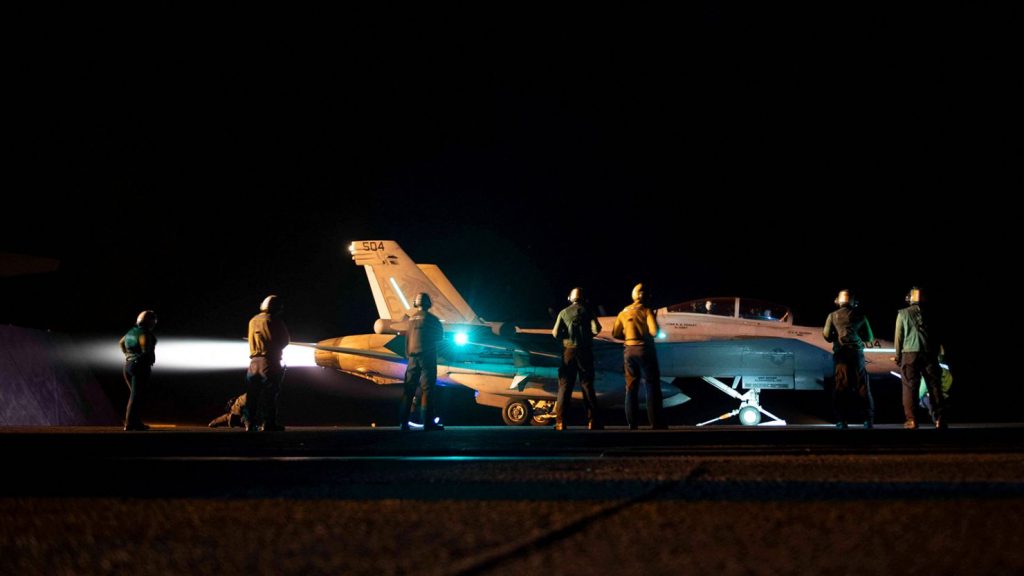US carries out second consecutive night of strikes in Yemen, defense official says
3 min read
File photo of a fighter jet launched from USS Dwight D. Eisenhower during a February 3, 2024 strike against Houthi military targets in Yemen. U.S. Navy/Jorge LeBaron/Handout/Reuters/File
The United States carried out a second consecutive night of airstrikes targeting Houthi positions in Yemen, a US defense official confirmed on Sunday. Although specific details about the weapons, targets, or locations were not immediately disclosed, reports indicated explosions in the Amran and Saada governorates, regions north of Yemen’s capital, Sanaa, where the US has previously conducted strikes against the Houthi militia.
The airstrikes, which took place Saturday night, involved US fighter jets targeting Houthi facilities in at least three locations. These facilities were linked to the storage of advanced conventional weapons, including those used by the Iran-backed rebel group to threaten US warships and commercial vessels operating in the Red Sea and the Gulf of Aden. The Red Sea is a crucial waterway, connecting to the Suez Canal, a major global shipping route through which 10% to 15% of world trade flows. Ongoing attacks along this route have disrupted maritime traffic and raised concerns over regional security.
The Houthis, an armed group based in Yemen, are part of a broader Iran-led alliance that includes Hamas and Hezbollah. These groups have increasingly coordinated their actions, targeting Israel and its allies as part of the wider regional conflict. The Houthis, in particular, have vowed to continue their attacks against Israel and its allies until a ceasefire is reached in Gaza.
Yemen’s ongoing conflict, which began in 2014 when Houthi forces seized the capital, Sanaa, and toppled the internationally recognized, Saudi-backed government, has led to a devastating humanitarian crisis. The war has severely strained Yemen’s resources, with over 34 million people living in conditions marked by food shortages, malnutrition, and inadequate access to healthcare. The situation has been exacerbated by natural disasters, including deadly flooding earlier this year, which displaced an additional 4.5 million people and made it even more difficult for humanitarian aid to reach those in need.
The US has consistently targeted Houthi positions over the past 11 months as part of its efforts to curb the militia’s destabilizing influence in the region. These operations have been in response to the Houthi group’s growing aggression against US interests and its involvement in attacks on shipping in the Red Sea. In mid-October, Defense Secretary Lloyd Austin confirmed that the US had deployed stealth B-2 bombers to strike Houthi targets for the first time. B-2 bombers are among the most advanced long-range strike aircraft in the US arsenal, capable of carrying larger payloads than fighter jets, making them a potent tool in targeting Houthi military infrastructure.
The B-2 strike was authorized by President Joe Biden, who directed the military to take action in response to the Houthis’ “illegal and reckless” attacks. The US government has repeatedly emphasized that these strikes are designed to hold the Houthis accountable for their actions, signaling a firm stance against the group’s activities.
In the context of the broader Middle East, the US has strengthened its military presence in the region in recent months, particularly in response to the ongoing conflict between Israel and Hamas in Gaza, as well as escalating tensions with Hezbollah in Lebanon. The US has deployed a carrier strike group, additional guided missile destroyers, an amphibious ready group, a marine expeditionary unit, and a variety of aircraft to bolster its regional defense posture. This increased presence underscores the US’s commitment to supporting its allies and safeguarding critical international shipping lanes in the face of growing instability in the region.
The US airstrikes in Yemen are part of a broader strategy aimed at curbing the influence of Iran-backed militias in the region. While the US has ramped up its military response, the Houthis have shown little indication of backing down, continuing their attacks against both regional and international targets. The situation in Yemen remains volatile, with the ongoing conflict contributing to one of the world’s worst humanitarian crises, and the US military’s actions in the region remain central to efforts to curb further escalation.








